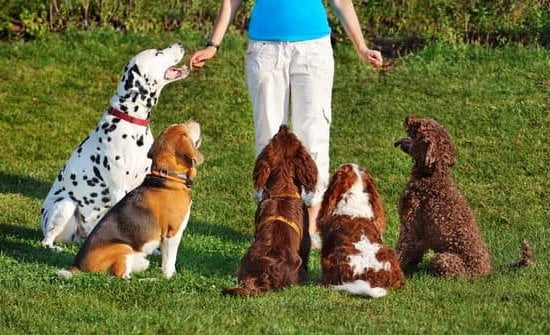Training your dog to do basic tricks is not only a fun and rewarding experience but also an essential aspect of responsible pet ownership. In this article, we will explore the importance of training your furry companion and provide you with a comprehensive guide on how to effectively teach your dog some impressive skills.
By understanding your dog’s behavior, establishing trust, and using the right tools and techniques, you can build a strong bond with your canine friend while also improving their obedience and discipline.
Dogs are intelligent animals that thrive on mental stimulation and physical activity. Training not only helps in shaping their behavior but also provides them with much-needed mental exercise. By teaching your dog basic commands like sit, stay, come, and down, you can ensure their safety and well-being in various situations. Additionally, training sessions offer an opportunity for bonding and communication between you and your furry friend.
By following a step-by-step guide on teaching basic tricks, troubleshooting common challenges, advancing to more complex commands, maintaining consistency in practice, and celebrating successes, you can make the training process enjoyable for both you and your dog. Remember that patience, positive reinforcement, and understanding are key to successful training sessions. So let’s dive into the world of training and discover how you can unleash your dog’s full potential through basic tricks.
Learning the Basics
When it comes to training your dog to do basic tricks, understanding your dog’s behavior and communication is crucial. Dogs communicate primarily through body language, vocalizations, and actions. To effectively train your dog, you must first learn how to interpret their signals and cues.
Body Language
Dogs use their body language to express a wide range of emotions, from excitement to fear. Tail wagging, ear position, and facial expressions all play a role in how dogs communicate. By observing your dog’s body language during training sessions, you can better understand their reactions to different commands and adjust your training approach accordingly.
Vocalizations
In addition to body language, dogs also use vocalizations such as barking, growling, whining, and whimpering to communicate. Pay attention to the sounds your dog makes during training sessions as they can provide valuable insights into their state of mind. For example, a high-pitched bark may indicate excitement or eagerness to perform a trick, while a low growl could signal frustration or confusion.
Actions
Lastly, dogs communicate through their actions and behaviors. From wagging their tail when pleased to rolling over in submission, every action has a meaning. By observing how your dog responds to different training techniques and commands, you can tailor your approach to suit their individual needs and preferences. Understanding your dog’s behavior and communication will not only enhance your bond but also make the training process more effective and enjoyable for both you and your furry friend.
Setting the Foundation
Building a strong foundation with your dog is essential when it comes to training them to do basic tricks. Trust and a strong bond are key elements in successfully teaching your furry friend new commands. Here are some tips on how to establish trust and build a strong bond with your dog:
- Spend quality time with your dog: Dedicate time each day to interact, play, and bond with your dog. This will help strengthen the connection between you two.
- Use positive reinforcement: Rewarding good behavior with treats, praise, and affection is crucial in building trust and reinforcing the bond you share with your dog.
- Be patient and consistent: Training takes time and consistency is key. Stay patient with your dog and always reward their efforts, even if progress is slow.
Another important aspect of setting the foundation for training is understanding your dog’s body language and behavior. By paying attention to how they communicate, you can better address their needs and create a more effective training environment. Remember that every dog is unique, so it’s essential to tailor your training approach to suit their individual needs.
- Learn to read your dog’s cues: Observe how your dog reacts in different situations and understand what signals they may be sending. This will help you communicate more effectively during training sessions.
- Establish clear routines: Dogs thrive on routine, so establishing a schedule for training, feeding, playtime, and rest can help create a sense of security and predictability for them.
- Show empathy and understanding: Building trust also involves showing empathy towards your dog’s emotions. Be attuned to their feelings and provide comfort when needed.
By focusing on trust-building activities, understanding your dog’s behavior, and communicating effectively, you’ll be able to set a solid foundation for successful trick training sessions with your furry companion. Remember, patience, consistency, and positive reinforcement are key components in creating a harmonious relationship based on mutual trust and respect.
Essential Equipment
Dogs are intelligent creatures, and with the right tools and treats, training them to do basic tricks can be a fun and rewarding experience for both you and your furry friend. When embarking on the journey of teaching your dog new skills, having the essential equipment at hand is crucial for successful training sessions.
Training Tools
To effectively train your dog, it is important to have the right tools. One of the most commonly used tools in dog training is a clicker. Clickers provide a clear and distinct sound that marks the exact moment when your dog performs a desired behavior, making it easier for them to understand what they are being rewarded for. Additionally, having a well-fitted collar and leash is essential for maintaining control during training sessions.
Tasty Treats
Using treats as rewards is an effective way to motivate your dog during training. When selecting treats, opt for small, soft pieces of food that are highly palatable to your dog. This could be pieces of cooked chicken, cheese, or commercial dog treats. Remember that treats should be enticing enough to hold your dog’s interest but small enough that they can consume them quickly without getting full.
Training Pouch
Investing in a training pouch can make your sessions more efficient by keeping treats easily accessible while keeping your hands free. A training pouch allows you to quickly reward good behavior and maintain focus during training sessions. Choose a pouch that is easy to clean and has multiple compartments to store different types of treats for variety.
By having the right tools and tasty treats on hand, you can create a positive learning environment for your dog that will facilitate their understanding of basic commands and tricks. Consistency in using these essential equipment items will not only make training easier but also strengthen the bond between you and your canine companion as you embark on this enjoyable journey together.
Step-by-Step Guide
Training your dog to do basic tricks like sit, stay, come, and down commands is not only fun but also essential for their well-being and development. By teaching these fundamental commands, you are fostering good behavior and improving communication with your furry friend. Here is a step-by-step guide on how to train a dog to do these basic tricks:
- Sit Command: Start by holding a treat close to your dog’s nose and slowly move your hand up. This will naturally make your dog lower its rear end to the ground. Once in the sitting position, say “sit” and give them the treat as a reward. Repeat this several times until they associate the action with the command.
- Stay Command: Begin by commanding your dog to sit or lie down. While in that position, hold out your hand like a stop sign and say “stay.” Take a step back and wait a few seconds before returning to them to provide praise and treats. Increase the distance gradually as they become more comfortable staying in place.
- Come Command: Use a long leash for this command initially. Begin by saying “come” in an upbeat tone as you gently tug on the leash towards you. When they reach you, shower them with praise and treats. Practice this in various environments to reinforce the command effectively.
- Down Command: Start by commanding your dog to sit, then show them a treat held close to the ground between their front paws. Slowly move it forward so they follow it into a lying-down position. As soon as they are down, say “down” and reward them with treats. Repeat this process consistently for better results.
By following these steps consistently and using positive reinforcement techniques such as treats, praise, and patience, you can successfully train your dog to master these basic tricks. Remember that each dog learns at their own pace, so be patient and understanding throughout the training process. With time and practice, both you and your furry companion will enjoy a stronger bond built on effective communication through these commands.
Remember always not only how training can help teach fun tricks but how obedience helps ensure safety for your pet when outdoors or interacting with others.
Troubleshooting Common Challenges
Training your dog to do basic tricks like sit, stay, come, and down commands can be a fun and rewarding experience for both you and your furry friend. However, along the way, you may encounter some common challenges such as dealing with distractions and lack of motivation. It’s important to address these issues effectively to ensure successful training sessions.
One key tip on how to train a dog to do basic tricks is to start training in a quiet and familiar environment free of distractions. This will help your dog focus better on the task at hand without being easily distracted by external factors. As your dog becomes more proficient in performing the basic commands, gradually introduce distractions in a controlled manner to simulate real-world scenarios.
Another common challenge many dog owners face during training is a lack of motivation from their canine companion. To overcome this hurdle, it’s essential to make training sessions engaging and rewarding for your dog. Use high-value treats or toys as rewards when they successfully perform a trick, and shower them with praise and affection. Remember, positive reinforcement goes a long way in motivating your dog to learn new tricks and commands.
Advanced Tricks
As your dog becomes more proficient in basic commands like sit, stay, come, and down, you may want to challenge them with more complex tricks. This not only keeps their training sessions engaging but also stimulates their mental abilities.
One of the keys to successfully teaching your dog advanced tricks is breaking down the behavior into smaller steps that are easily understood. For example, if you want to teach your dog how to roll over, you can start by getting them comfortable with lying down on their side before progressing to the full roll.
To begin training your dog on advanced tricks, it’s essential to have a strong foundation in basic obedience commands. Advanced tricks often require a higher level of focus and control from your dog, so ensuring they have mastered fundamental behaviors will make the learning process smoother.
Additionally, using high-value treats or rewards can motivate your dog during training sessions for more challenging tricks. Remember to keep training sessions short and positive to maintain your dog’s engagement and enthusiasm.
When introducing more complex commands and tricks to your dog, patience is key. Some dogs may pick up new behaviors quickly while others may take more time to understand what is being asked of them. Be consistent in your training methods and always provide clear cues for the desired behavior. If you encounter any challenges along the way, such as lack of motivation or distractions, go back to basics and reinforce previously learned commands before moving forward with advanced tricks.
| Behavior | Description |
|---|---|
| Roll Over | Teach your dog to roll over by starting with lying on their side. |
| Fetch | Gradually introduce fetching objects by rewarding each step towards completion. |
| Dance | Encourage your dog to stand on hind legs and move in rhythm with music through shaping techniques. |
Consistency Is Key
Training your dog to do basic tricks requires consistency and a systematic approach. One of the most important aspects of training your furry friend is regular practice. Repetition is key when teaching your dog commands such as sit, stay, come, and down. By establishing a consistent training schedule, you can reinforce these commands effectively.
When training your dog, it’s essential to use positive reinforcement to encourage good behavior. This can include verbal praise, treats, or toys as rewards for successfully performing a trick. Dogs respond well to positive feedback, so be sure to celebrate their success each time they follow a command correctly. Consistency in rewarding good behavior helps reinforce the learning process and strengthens the bond between you and your pet.
In addition to regular practice and positive reinforcement, it’s important to be patient with your dog during training sessions. Remember that every dog learns at its own pace, so it’s essential to remain calm and consistent throughout the process. By understanding your dog’s individual needs and tailoring your training methods accordingly, you can effectively teach them basic tricks while building a strong foundation for more advanced commands in the future.
| Consistency Is Key | Regular Practice and Positive Reinforcement |
|---|---|
| Consistency in training schedule | Repetition is key |
| Use of positive reinforcement | Celebrate success with rewards |
| Patience during training sessions | Tailor methods to individual dog’s needs |
Celebrating Success
Training your dog to do basic tricks is not only a fun and rewarding experience for both you and your furry friend but also an essential part of their overall well-being. Celebrating your dog’s success during training sessions plays a crucial role in reinforcing positive behavior and strengthening the bond between you and your pet. By acknowledging their achievements and progress, you are encouraging them to continue learning and growing in their abilities.
One of the key aspects of celebrating your dog’s success is through rewarding them with treats, praise, toys, or any other form of positive reinforcement that they enjoy. This positive feedback helps reinforce the connection between performing a trick correctly and receiving a reward, making them more likely to repeat the behavior in the future. Remember to be consistent in your rewards and always provide them immediately after they successfully complete a command to reinforce the desired behavior effectively.
Reflecting on the progress your dog has made throughout their training journey is also important in celebrating their success. Take time to look back at where they started, how far they have come, and all the hard work both you and your dog have put into learning new tricks together.
Celebrate each milestone achieved, no matter how small it may seem, as every step forward is a testament to your dedication and commitment to helping your canine companion thrive. Ultimately, by acknowledging and celebrating your dog’s accomplishments, you are not only rewarding them for their hard work but also creating a positive training environment that will benefit both you and your pet in the long run.
Frequently Asked Questions
What Is the Easiest Trick to Teach a Dog?
Teaching a dog to sit is often considered the easiest trick to teach. It is a basic command that can be easily reinforced through positive reinforcement with treats or verbal praise. Most dogs quickly understand and master this command.
What Are the 7 Basic Commands for Dog Training?
The 7 basic commands for dog training are sit, stay, come, down, heel, no, and leave it. These commands form the foundation for obedience training and help establish clear communication between a dog and their owner.
What Is the Hardest Command to Teach a Dog?
The hardest command to teach a dog is often considered to be “stay.” This command requires patience, consistency, and practice as it goes against a dog’s natural instincts to move around. It can be challenging for some dogs to stay in one place without getting distracted or wanting to follow their owner.

Welcome to the blog! I am a professional dog trainer and have been working with dogs for many years. In this blog, I will be discussing various topics related to dog training, including tips, tricks, and advice. I hope you find this information helpful and informative. Thanks for reading!





